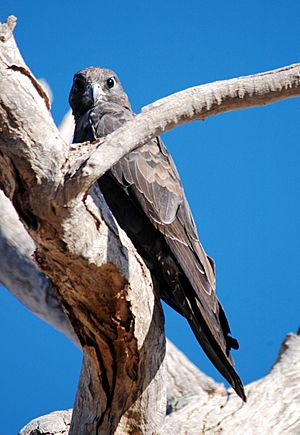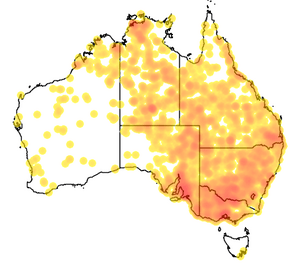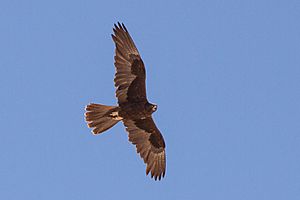Black falcon facts for kids
Quick facts for kids Black falcon |
|
|---|---|
 |
|
| Conservation status | |
| Scientific classification | |
| Genus: |
Falco
|
| Species: |
subniger
|
The black falcon (Falco subniger) is a medium-sized falcon found only in Australia. It lives in all mainland states and territories. Even though it's widespread, it's considered Australia's least studied falcon.
Contents
What Does the Black Falcon Look Like?
Black falcons are known for their dark feathers.
Size and Weight
- Adults are about 45 to 56 centimeters long from beak to tail. The average length is 50 centimeters.
- Their tail makes up about half of their total length.
- Female black falcons are larger than males. This is called sexual dimorphism, which means males and females of the same species look different.
- Females weigh around 833 grams.
- Males weigh about 582 grams.
- Their wingspan, from wingtip to wingtip, is 95 to 115 centimeters.
Colors and Features
- They are usually dark brown to black all over.
- Young falcons are often darker than adults.
- The feathers under their wings have two tones, with flight feathers being a bit lighter.
- Adults might have a dark stripe below their eye.
- Sometimes, they have a white chin or spots under their wings.
- Their cere (the fleshy part above the beak), eye ring, and feet are pale grey or blue-grey.
- Their eyes are dark brown, and the tip of their beak is black.
- Their talons (claws) are black.
- Baby falcons are covered in white downy feathers.
Body Shape
- The black falcon has a sleek body with a long tail and a slim build.
- Its wings are long and pointed, getting narrower towards the tips.
How to Tell Them Apart
- When identifying a flying raptor (bird of prey), it's helpful to look at its shape, how it flies, and its calls.
- You can tell Australian falcons apart from hawks because falcons have a "tooth" on their upper mandible (beak) and long, pointed wings.
- The Brown falcon (Falco berigora) is often confused with the black falcon. However, they differ in leg length, flight style, and wing position. Brown falcons also have clear bars on their underwings and tail.
Black Falcon Family Tree
The black falcon belongs to the Falconidae family. This family also includes the three other falcon species found in Australia: the brown falcon, grey falcon (Falco hypoleucos), and peregrine falcon (F. peregrinus).
Scientists have studied their genes and found that the black falcon might be an early relative of the Old World hierofalcons, like the saker falcon (F. cherrug).
How Many Black Falcons Are There?
The black falcon is listed as "least concern" by the IUCN (International Union for Conservation of Nature). This means it's not currently at high risk of extinction.
- It's generally considered uncommon and moves around a lot.
- However, it has a strong population in inland Queensland.
- In New South Wales (NSW) and Victoria, it is listed as "Vulnerable," meaning it faces a higher risk there.
- In 2009, experts estimated there were between 670 and 6,700 adult black falcons. Their numbers seem to be stable.
Where Do Black Falcons Live?
Black falcons live across mainland Australia. They avoid areas with very dense forests. You might see them less often in southern Western Australia and coastal areas of southeastern Australia. Sometimes, they even visit New Zealand, but they don't breed there.
Their total living area is estimated to be about 5.9 million square kilometers.
Black Falcon Homes
- Black falcons usually live in dry and semi-dry areas.
- They are often found near rivers or isolated groups of trees.
- They hunt over open grasslands, plains with saltbush or bluebush, and other areas with low plants.
- In dry regions, they hunt near wetlands or temporary water bodies. These spots attract many birds, which are their main food source.
Black Falcon Behavior
Black falcons are known to bother other birds, including other birds of prey and crows. They also get bothered by other birds. They might rest on power poles during the day but won't sit on wires.
How They Fly and Hunt
- The black falcon's flight style can vary.
- They often fly with relaxed wingbeats, similar to a crow, and sometimes soar high in the sky.
- They can also fly with stiffer, faster wingbeats.
- When gliding or soaring, their wings are slightly drooped or flat, with the "wrists" (carpals) pushed forward.
- Their tail is usually folded, but when soaring, it fans out with notched corners.
- They often soar for a long time without flapping their wings.
- They catch prey both in the air and on the ground.
- When chasing prey, they use powerful, fast wingbeats.
- When resting, their wingtips are shorter than their tail, and their legs look short.
Hunting Together
- Black falcons usually hunt alone.
- However, they have been seen hunting in pairs, and sometimes even in larger groups. This happens when there's a lot of food available, like during stubble fires that attract many prey animals. For example, twelve falcons were once seen at a fire in New South Wales.
Hunting Techniques
- They often hunt by flying low over treetops, surprising and catching birds in flight.
- They sometimes chase other birds for long distances.
- Less often, they will dive vertically at prey, similar to a peregrine falcon.
- Black falcons hunt other birds of prey and are sometimes hunted by them too.
What Do Black Falcons Eat?
The black falcon mainly eats other birds, from small finches to large cockatoos. They also eat small mammals like rabbits, mice, and rats, as well as insects and dead animals.
Here are some of the birds they eat:
- Various pigeons, including the crested pigeon and the feral rock dove.
- Australasian pipit
- Australian magpie
- Australian ringneck
- Black-faced cuckooshrike
- Blue bonnet
- Budgerigar
- Common starling
- Eastern rosella
- Fairy martin
- Galah
- Grey Teal
- Honeyeaters
- Horsfield's bush lark
- Little buttonquail
- Little corella
- Musk lorikeet
- Stubble quail
- Zebra finch
They have also been seen trying to hunt turquoise parrots and apostlebirds, but these attacks were not successful.
Breeding and Raising Young
- Black falcons lay their eggs between May and November, usually from July to September.
- A female lays 1 to 5 eggs, but usually 3 or 4.
- The eggs are about 42 by 32 millimeters in size.
- The female incubates the eggs for about 34 days. The male might help for short periods.
- The nestling period, when the young birds are in the nest, lasts about 5.5 to 7 weeks.
- Black falcons can live for at least 12 years in the wild and up to 20 years in captivity.
Nesting Habits
- Black falcons build their nests in living or dead trees.
- They often use stick nests built by crows or other raptors.
- They might even take over nests that are already occupied by other birds.
- There might be competition for nest sites between black falcons and other birds of prey or crows.
- Finding suitable nest sites can be a challenge for black falcons, especially in areas where many trees have been cleared, like in the sheep-wheat farming regions of New South Wales.
Courtship and Parenting
- During breeding season, male falcons perform courtship displays, flying in horizontal figure-eight patterns around the nest.
- The male brings food to the female while she is incubating the eggs and brooding the young.
- Later, when the young falcons are growing, both parents may hunt to feed their chicks.
- After leaving the nest, young falcons behave much like young peregrine falcons. They spend time with their siblings and parents, practicing hunting, defending territory, and courtship behaviors.
Black Falcon Calls
- The most common call sounds like a slower, deeper version of the peregrine falcon's "cackle," like "gaak-gaar-gaak."
- When attacked or when intruders are near, their guttural call becomes shorter and faster, like "gak-gak-gak-gak."
- Some people think the bird screams when attacking prey, but others disagree, saying they are usually silent during an attack.
- The male makes a sharp, high-pitched "eeik..eeik..eeik" or "ee-chip…ee-chip" during courtship.
- The female makes a whining or wailing sound when asking for food or during mating.
Where They Roam
- The exact size of a black falcon's home range is not fully known, but it's likely larger than 100 square kilometers.
- They seem to travel widely when they are not breeding.
- However, they are also known to stay in the same non-breeding areas for long periods.
Threats and Protecting Black Falcons
The decreasing number of black falcons is a growing concern. Two states, Victoria and New South Wales, have already listed the species as vulnerable. Experts say that we need more information about their population and behavior to help them.
Main Threats
The biggest threats to black falcons are caused by humans. These include:
- Habitat clearing: Removing the places where they live.
- Habitat degradation: Damage to their homes from things like too much grazing by livestock.
- Collisions: Hitting vehicles.
- Shooting: Being shot.
- Clearing large, old trees and breeding sites near rivers is especially worrying.
Other Challenges
- Black falcons also face competition from crows and other birds of prey for nest sites and possibly for food.
- Disturbances at nest sites and harassment by other birds (including cockatoos) can also affect how well they breed.
How We Can Help
To help black falcons, experts recommend:
- Monitoring: Keeping track of their populations.
- Research: Learning more about their biology and how they live.
- The Office of Environment and Heritage in New South Wales has listed eight main actions to help the species recover. These include:
- Protecting and watching known nest sites.
- Protecting old stick nests that could be good breeding spots.
- Protecting and growing large, old trees.
- Working with landowners to manage their habitat.
- Expanding their habitat, especially along river areas.
- Researching what they eat.
- Raising awareness about the species.
Victoria does not currently have a specific recovery plan for the black falcon.
See also
 In Spanish: Halcón negro para niños
In Spanish: Halcón negro para niños




